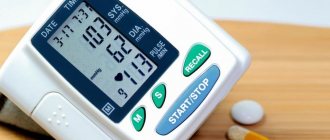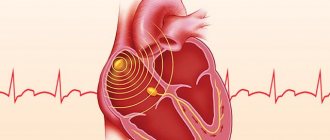Hypotension - features of the disease
Arterial hypotension (hypotension) – a decrease in blood pressure by 20% or more. Normally this figure is 120∕80 mm. rt. Art., then hypotension is diagnosed when systolic pressure drops to 90, and diastolic pressure drops to 60 mm. rt. Art. The disease can be congenital or acquired, develop as an independent disease or accompany other pathologies.
Causes of hypotension
In most patients, hypotension develops with a decrease in vascular tone. Normally, their walls should expand and contract due to the muscle layer, in response to an increase or decrease in fluid in the bloodstream. However, with some diseases, muscles become weak and unable to adapt to changes. A decrease in circulating blood is normally accompanied by a narrowing of the lumen of blood vessels so that it flows with sufficient force to organs and tissues. With hypotension, a decrease in blood and a slowdown in its movement lead to insufficient blood supply to the head and limbs, and then to other organs.
Hypotension often occurs in a chronic form. During its course, there is an alternation of periods of long-term remission and exacerbation. Seizures can be triggered by the following factors:
- chronic heart failure;
- neuroses, stress, insomnia, lack of rest during intense work;
- history of traumatic brain injury;
- a sharp decrease in the total amount of blood in the vessels (burns, injuries, blood loss);
- physiological hypotension when the body adapts to being high in the mountains, as well as in athletes with well-trained heart muscle and a large volume of circulating blood.
With low blood pressure, headaches are the result of insufficient blood supply to the cells and tissues of the brain. Weakness of the vascular walls and other factors lead to permanent or temporary ischemia. This is a dangerous disorder in which nerve tissue lacks oxygen and nutrients. The result is headaches and other characteristic symptoms. In addition, prolonged cerebral ischemia is the main predisposing factor to the development of stroke.
Symptoms of low blood pressure
Acute or chronic hypotension is a dangerous disease in which organs and tissues are subject to ischemia. Symptoms are associated with these processes and therefore pose a danger to the body. They can be triggered by stress; they also often appear in stuffy rooms and with a lack of oxygen. A typical complex may include the following manifestations:
- general weakness, lethargy, fatigue;
- nausea and dizziness;
- headache;
- pallor of the skin and mucous membranes.
If your blood pressure drops sharply and you have a headache, you may faint. This often occurs in poorly ventilated areas at high air temperatures. Symptoms quickly appear and increase, the patient experiences tinnitus, deterioration of hearing and vision. It is important to provide first aid in a timely manner in case of an acute attack of hypotension.
A sharp decrease in blood pressure from 100 to 60 - first aid
A person's blood pressure is 100 over 60 and is dangerous if it has dropped quickly from normal levels. This happens in the following cases:
- blood loss after injury,
- a consequence of prolonged lying position of the patient,
- severe infections
- diarrhea,
- taking diuretics and antihypertensive drugs,
- internal bleeding from the stomach or intestines,
- physical exhaustion,
- lowering blood glucose in diabetics,
- allergic conditions,
- paroxysmal tachycardia,
- atrial fibrillation,
- myocardial infarction,
- taking drugs.
In such cases, emergency assistance is required. A sharp decrease in blood pressure is dangerous due to disruption of the blood supply to vital organs - the brain, heart.
What to do if your blood pressure drops quickly:
- without wasting time, call an ambulance,
- put the person on his back with his head down, while raising his legs,
- In the hospital, during infections, doctors restore the volume of circulating blood with intravenous drips of saline. At the same time, antibiotics are used
- in case of blood loss after injury, plasma and rehydrants are administered.
Important! Do not try to diagnose on the Internet and treat using traditional methods. Losing time can cost a person his life.
Headaches with low blood pressure
Headaches with low blood pressure can vary in nature and intensity. They can increase quickly if pressure readings decrease sharply, or accompany the patient constantly. The following features are characteristic of pain due to hypotension:
- lack of precise localization - discomfort spreads to the entire surface of the head;
- additional symptoms: nausea and dizziness;
- chronic course, with alternating periods of relief and exacerbation.
If your blood pressure is constantly low and your head hurts, this indicator must be maintained with medication. With prolonged use, migraine may develop. This is an acute headache that does not go away even after normalization of blood pressure and significantly affects performance.
Typical complications
Contrary to ideas, an arterial indicator of this kind is by no means safe.
The probability of consequences for the body is 5-8%, with a further decrease in blood pressure levels - 12-15%. Treatment should begin at the 90 to 70 stage; this is the best moment when you can be completely cured and forget about the disease.
Possible complications include:
- Fainting. A common problem that can occur to the patient several times a day. Injury and death are possible as a result of loss of control over the situation.
- Ischemic stroke. Insufficient trophism of nerve tissue will lead to the death of entire groups of neurons. The result is neurological deficit of varying degrees of intensity. From minimal changes to total disruption of fundamental functions. Damage to the brain stem can result in death.
- Cognitive problems. Dementia. Decreased memory and intensity of mental activity. As a result of constant hypoxia of the cerebral cortex.
- Problems with vision and hearing as an outcome of the same ischemia.
Diagnosis of headaches due to hypotension
It is important to determine the exact reason why your blood pressure drops and your headache occurs. It is not difficult to measure this indicator, including at home. It is enough to use a tonometer and determine that the pressure has been reduced to 90/60 mm. rt. Art. and less. However, doctors at the Clinical Brain Institute recommend undergoing a full examination if hypotension occurs frequently and is accompanied by headaches. To determine the cause of this disease, additional techniques may be required:
- general and biochemical blood tests, as well as determination of the rate of blood clotting;
- Dopplerography - ultrasound of blood vessels with the addition of a contrast agent, informative for diagnosing blood flow in the neck and head;
- MRI of the cervical spine - allows you to determine osteochondrosis, intervertebral hernias and other pathologies that impair blood circulation;
- electrocardiography, ultrasound of the heart - prescribed for suspected heart failure and other diseases.
At the Clinical Brain Institute, you can undergo comprehensive diagnostics, which will help determine the cause of chronic hypotension. Our main advantages are the availability of precise and modern equipment, high qualifications and many years of experience of our specialists. After examination and diagnosis, the doctor will select a treatment regimen to relieve attacks of hypotension and reduce the manifestation of headaches.
Warning signs
The signs of the pathological process are as follows:
- Headache in the back of the head. With such a slight decrease in blood pressure levels, they are noted to be of low intensity. Is it always like this? No. If a “habitual” hypertensive patient suffers from a drop in pressure, a painful manifestation occurs.
The clinical picture is as complete as possible. The body is not accustomed to even normal pressure levels, let alone low ones.
- Vertigo. The patient experiences a sensation of the world spinning around. In severe cases, orientation in space is impossible at all.
- Weakness in the legs.
- Visual impairment such as darkening of the eyes during sudden movements and changes in body position. Orthostatic hypotension.
- Noise and ringing in the ears.
- Nausea.
- Vomit.
- Confusion.
- Fainting up to several times a day.
- Tachycardia or bradycardia (arrhythmias)
The clinical picture is rarely isolated. If there is an underlying disease, there will also be focal symptoms. You need to pay attention to all sensations and accurately express your complaints to the doctor. Recall even seemingly insignificant facts.
Treatment methods
If the patient has low blood pressure, a headache, weakness and dizziness, it is necessary to restore normal blood flow through the vessels as quickly as possible. Then it is important to consult a doctor to select medications for a course of treatment. The regimen is prescribed individually, depending on general health, blood pressure readings, accurate diagnosis and concomitant diseases.
First aid
If your blood pressure drops, your head hurts, or your health suddenly deteriorates, this indicates an insufficient supply of oxygen to the brain cells. It is important to restore your blood pressure before seeing a doctor. To do this, doctors recommend using several methods:
- take caffeine - this substance has a vasoconstrictor effect and is found in coffee and strong tea;
- provide access to oxygen, ventilate the room or go outside;
- take a sitting position and lower your head down - this normalizes blood flow to the brain;
- Unbutton the collar, loosen the cuffs on the sleeves.
After these manipulations, the pressure will return to normal, but the attack may recur. It is also important to notice its onset in time. If your health has sharply deteriorated, your head hurts, dark circles appear before your eyes, you must immediately inform others about the problem and ask for help.
Drug treatment
For the comprehensive treatment of headaches due to hypotension, a course of medications is prescribed. Some of them are designed to quickly narrow blood vessels and restore blood flow and are used to relieve attacks. The doctor will also recommend medications for a course of treatment. The regimen may include the following drugs:
- drugs that stimulate an increase in blood pressure, including those based on caffeine (Pyramein, Caffetamine);
- medications to improve blood supply to brain tissue and to prevent stroke (Glycine, Tanakan);
- herbal preparations for raising blood pressure and normalizing the functioning of the nervous system (tincture of Eleutherococcus).
The effectiveness of treatment must be constantly monitored by measuring blood pressure. To do this, it is enough to use a tonometer once every few days. Monitoring indicators too frequently leads to disruption of the nervous system and neuroses, which can provoke additional attacks of hypotension. Doctors at the Clinical Institute of the Brain will select a suitable treatment regimen, which will include only useful and necessary drugs, without unnecessary prescriptions and procedures. However, it is important to follow all instructions and take medications as scheduled.
Is 90 to 70 normal?
As follows from the protocols of the same World Health Organization, it is necessary to take into account the individual working standard, but it should not be below 100.
This is already an indication of pathological changes in the patient’s body. But this is not always the case. There are many physiological factors that can slightly reduce blood pressure levels. It also happens to smaller numbers.
Thus, when assessing normality, not only the tonometer indicators should be taken into account, but also the individual characteristics of the patient’s body and its physiology.
Prevention methods
Low blood pressure can be either congenital or acquired. In young people, hypotension is often caused by stress, poor diet, and vitamin deficiency (especially A, C and E). In order to maintain the health of the cardiovascular system and prevent most dangerous diseases, it is enough to follow a few simple advice from doctors:
- spend less time in stuffy rooms - this leads to oxygen starvation of cells and tissues;
- ensure proper rest - daily sleep of at least 7-8 hours is important for restoring the body after a working day;
- regularly engage in sports at an amateur level - the muscular layer of the vascular walls and myocardium also need constant training;
- eat well, get enough vitamins;
- Every morning, do a little exercise to improve blood circulation before getting up - this will help prepare the cardiovascular system for the start of the day and avoid sudden stress.
Often a headache with low blood pressure is a dangerous symptom. Doctors at the Clinical Institute of the Brain recommend not to self-medicate, since hypotension is often chronic and can progress. It is important to undergo an examination in time and select medications that will strengthen blood vessels, improve blood circulation, relieve headaches and prevent the dangerous consequences of the disease.
For whom 100 by 60 mm RT. Art. – norm
For most young people, mainly women, a constant pressure of 100 over 60 is normal. This indicator occurs:
- with normal or low weight,
- for non-smokers,
- athletes,
- physically active,
- with constitutional features.
Important! If 100 to 60 remains constant, and there are no complaints and you feel good, there is no need to take therapeutic measures. This blood pressure value does not pose any danger.
What does a tonometer level of 80/50 mean?
Such blood pressure numbers indicate problems in the body. But not always.
Physiological factors also occur, but their share in the total number of clinically significant situations is quite small, about 30%.
Diseases are much more common, the remaining 70% are problems with the heart, blood vessels, hormonal levels and nervous system, less often the kidneys and excretory tract.
Hypotension does not always carry the same danger. Patients with a chronic increase in blood pressure, as well as people whose normal working pressure is above 130 to 80, experience much greater discomfort, and such a tonometer reading for them is determined by a significant threat.
For your information: the likelihood of complications in patients with hypertension when blood pressure decreases is almost three times higher.
Symptoms
Hypotension - even the physiological form - can be accompanied by the development of pathological symptoms. Signs of hypotensive changes will include:
- weakness, drowsiness, fatigue;
- strong reaction to weather changes (meteosensitivity);
- violation of thermoregulation - legs and arms are almost always cold and freezing;
- increased sweating;
- headaches localized to the forehead;
- poor tolerance to physical/psycho-emotional stress;
- pale skin;
- motion sickness;
- occasional nausea.
Important! Hypotonic patients need a longer night's rest. For the human body to rest and recover, it needs 10-12 hours.
If you have such symptoms, you should consult with your doctor, who will determine the true cause of hypotension and prescribe adequate treatment for the condition.











